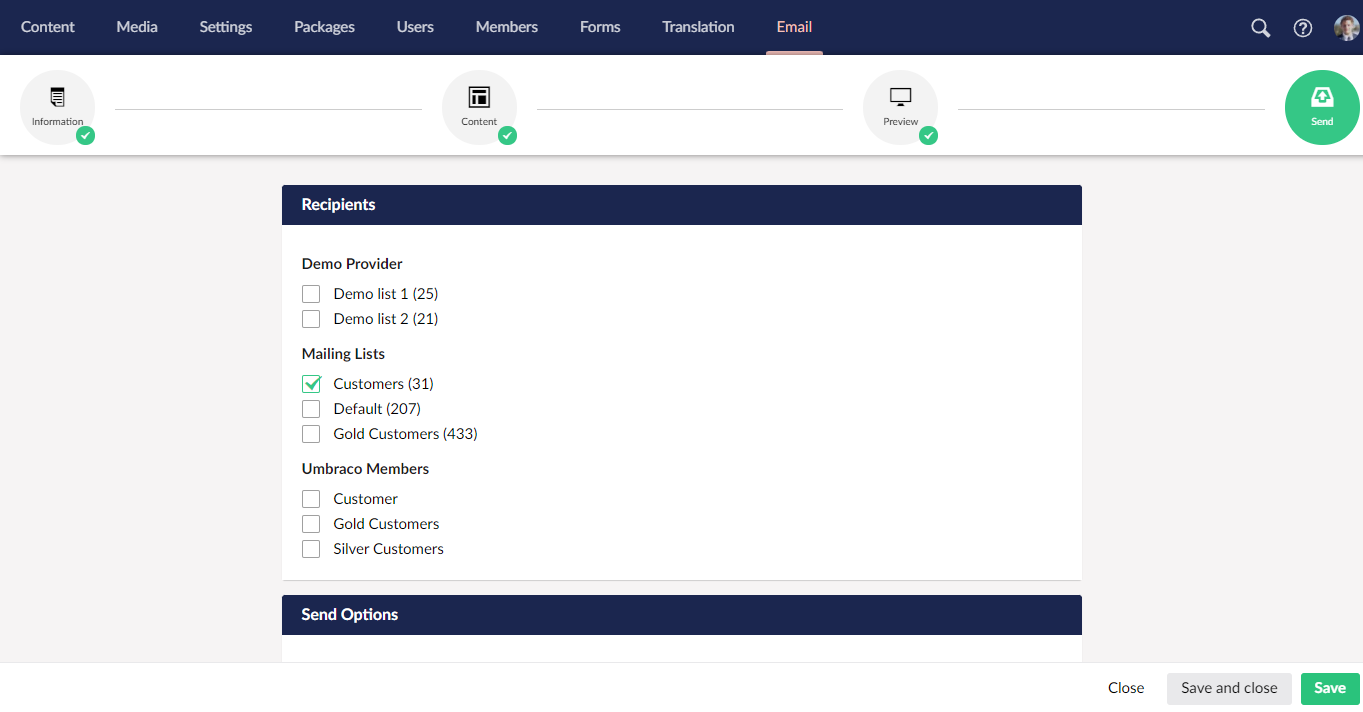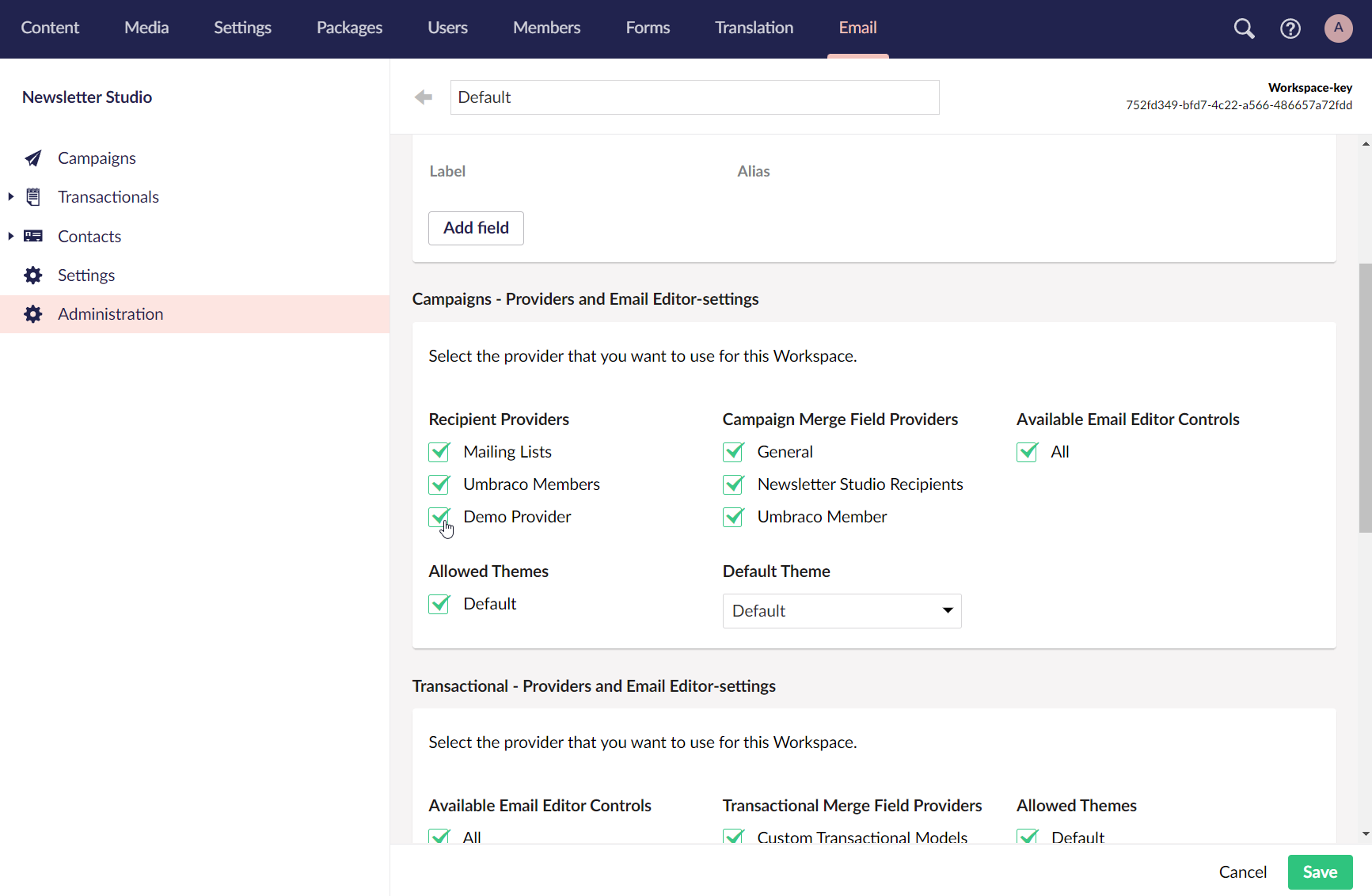These providers expose lists and recipients for Campaigns. For example, the list shown when sending a campaign are all fetched from our build in Recipient List Provicers.

Developers can create custom Recipient Providers to expose lists from any custom source. That could be a CRM, a webshop, a custom database table, or any other data source.
The custom class needs to implement IRecipientListProvider and needs to be registered during startup. It's also common to implement a Merge Field Provider to work in conjuntion with the Recipient List Provider. This is required if you want to use merge fields from your custom Recipient List Provider inside emails.
The custom provider will be used to show lists a options in the Send-step of the edior and also to create a queue during send out. There is no built in way to show/list/browse the recipients in a custom Recipient List Provider - only the built in Mailing Lists are shown the package UI. Most of the time there is already existing UI for the source (think of Umbraco Members) but if you need this you can always extend Umbraco to implement custom dashboards/views to show the data.
Here is a example of a custom Recipient List Provider with hardcoded values.
A working Umbraco-website with this provider can be found in our contrib-project.
Most of the types and methods have XML-comments and documentation - use your IDE and hover types/methods to read more information.
public class InMemoryRecipientListProvider : IRecipientListProvider
{
private readonly IUmbracoContextFactory _umbracoContextFactory;
public string DisplayName => "Demo Provider";
public string DisplayNameLocalizationKey => "site/demoProvider";
public string Prefix => "ex";
public bool CanRedirectToEdit => false;
public InMemoryRecipientListProvider(IUmbracoContextFactory umbracoContextFactory)
{
// You can inject dependencies in the constructor if needed.
// Providers are created as Singletons, keep this in mind when
// injecting your dependencies.
_umbracoContextFactory = umbracoContextFactory;
}
/// <summary>
/// Called when we present available lists to the users, e.g. in the last step
/// before sending a campaign.
///
/// Should return a list of available lists that this provider exposes.
/// Examples: Built in provider = Mailing Lists, Umbraco Members = List of groups
/// </summary>
/// <param name="workspaceKey"></param>
/// <returns></returns>
public List<RecipientList> GetLists(Guid workspaceKey)
{
/*
* Note here that each item in the list has a RecipientListIdentifier
* This identifier is used to uniquely identify the list and will be passed
* to other methods in this class to retrieve details.
*/
return new List<RecipientList>()
{
new RecipientList()
{
// Replace 1 with a unique identifier (int-id, guid etc) of your list.
Identifier = new RecipientListIdentifier(Prefix, 1),
Name = "Demo list 1",
Subscribers = 25
},
new RecipientList()
{
Identifier = new RecipientListIdentifier(Prefix, 2),
Name = "Demo list 2",
Subscribers = 21
}
};
}
/// <summary>
/// This method is called bu Newsletter Studio to build a for a campaign based on the lists
/// that the user selected. The package will handle duplicates if the same email is present in
/// more than one list.
///
/// Notice that the <see cref="RecipientListIdentifier"/> from the <see cref="GetLists"/>-method
/// is passed here and will contain your unique identifier.
///
/// This method should return a list of <see cref="EmailReceiver"/> that will be used to build the queue.
/// </summary>
/// <param name="listId"></param>
/// <param name="parameters"></param>
/// <returns></returns>
public List<EmailReceiver> GetReceiversForList(RecipientListIdentifier listId, GetReceiversForListParams parameters)
{
var list = new List<EmailReceiver>();
list.Add(new EmailReceiver(new EmailReceiverIdentifier(Prefix, 1), "foo@bar.com", "Foo Bar"));
if (listId.Identifier == "2")
list.Add(new EmailReceiver(new EmailReceiverIdentifier(Prefix, 2), "foo2@bar.com", "Foo Bar"));
return list;
}
/// <summary>
/// This method is called by the package during the send out. I will be called one time for each recipient to get the
/// details based on the <see cref="EmailReceiverIdentifier"/> created in the <see cref="GetReceiversForList"/>-method.
///
/// These details are used to render the email and to provide values for any <see cref="ICampaignEmailMergeFieldProvider"/>.
/// </summary>
/// <param name="receiverId"></param>
/// <returns></returns>
public RecipientProviderRecipientDataModel GetDataModel(EmailReceiverIdentifier receiverId)
{
var model = new RecipientProviderRecipientDataModel();
model.Email = "foo@bar.com";
model.ProviderRecipientId = receiverId.ToString();
// The optional "Model"-property is used to pass a custom model that can be used inside
// a IMergeFieldProvider to translate properties into Merge Fields. Leave this as null
// if you do not need to pass any detailed data.
model.Model = new InMemoryRecipient()
{
BirthYear = 1975,
City = "London",
CompanyName = "Test Company Inc."
};
return model;
}
/// <summary>
/// This method is used when matching transactional recipients to existing recipients in the system.
/// Return a <see cref="EmailReceiver"/> based on the email passed in.
/// This method can return null if you data source does not support to query by email.
/// </summary>
/// <param name="email"></param>
/// <param name="workspaceKey"></param>
/// <returns></returns>
/// <exception cref="NotImplementedException"></exception>
public EmailReceiver GetByEmail(string email, Guid? workspaceKey = null)
{
throw new NotImplementedException();
}
/// <summary>
/// This method is called to unsubscribe a recipient from a given list.
/// </summary>
/// <param name="receiverId"></param>
/// <param name="listId"></param>
/// <returns></returns>
public bool Unsubscribe(EmailReceiverIdentifier receiverId, RecipientListIdentifier listId)
{
//TODO: Change status
return true;
}
/// <summary>
/// This method is called to unsubscribe a recipient from all lists in the provider.
/// </summary>
/// <param name="receiverId"></param>
/// <returns></returns>
public bool UnsubscribeAll(EmailReceiverIdentifier receiverId)
{
//TODO: Change status
return true;
}
public string GetEditUrl(EmailReceiverIdentifier receiverId)
{
// Used when CanRedirectToEdit is true to allow for redirection to a edit-view.
// Ig. the Umbraco Member-view for Umbraco members.
throw new NotImplementedException();
}
}
/// <summary>
/// A model to recipient data about a In Memory Recipient
/// </summary>
public class InMemoryRecipient
{
public int BirthYear { get; set; }
public string City { get; set; }
public string CompanyName { get; set; }
}
We also need to register the provider during startup:
public class MySiteComposer : IComposer {
public void Compose(IUmbracoBuilder builder)
{
builder.NewsletterStudio().RecipientListProviders.Append<InMemoryRecipientListProvider>();
}
}
After this we need to run the website and go to Administration -> Workspace and allow our custom provider for Campaigns:
